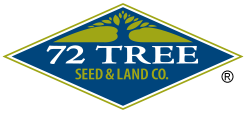Notice: Undefined variable: page in /home/vrxdg1855sn3/public_html/wp-content/themes/72tree/content.php on line 15
Notice: Trying to get property 'ID' of non-object in /home/vrxdg1855sn3/public_html/wp-content/themes/72tree/content.php on line 15
9 Common Tree Health Problems and Solutions
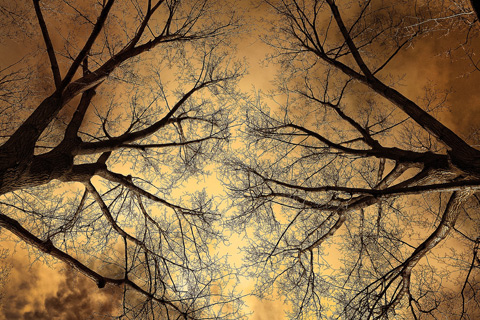
Trees get sick. Like any other living organism, a tree can fall ill for various reasons. If left to its own devices, it can eventually fall causing catastrophic damages.
When an otherwise healthy tree shows signs of illness or infestation, you must take action by eliminating the cause or calling on a certified arborist to evaluate the tree and offer a course of action.
The team of arborists at 72tree.com prepared a comprehensive list of 9 common tree health problems and their solutions.
Weather and Tree Health
Trees are affected by inconsistent weather patterns. The following demonstrates how weather impacts trees and how you can help them remain healthy.
1 – Drought:
One of the most common ailments of trees, symptoms of drought can be tricky. Sometimes, the signs won’t appear until as much as a year after the damage has been done. Those symptoms include:
•Drooping, wilting, and yellowing of leaves.
•Premature needle or leaf drop.
•Pronounced dieback.
•Thinning of the canopy.
•Deep cracks in the bark.
•Necrosis of leaves or browning of needles.
•Death of the tree.

Solution 1 – For planting new trees, make sure they are appropriate for the USDA Hardiness Zone in which you are located. If your area experiences occasional or frequent droughts, seek drought-resistant species.
Solution 2 – Water your trees regularly. New trees will require a deep watering once a week for the first two years (to establish its roots). In addition to watering, add a 3-inch layer of organic mulch around the tree to help the soil retain its moisture.
After two years and through its adult life, trees are very capable of finding water sources. However, throughout dry summer months and near the end of fall, weekly deep watering and mulching will help prevent drought problems.
Solution 3 – Prune back all cracked, dead or weakened tissue. Without pruning these troubled areas, the tree will become vulnerable to infection and infestation. Call on an arborist when pruning removes more than 25% of the tree’s canopy or mass. They can assess the tree and offer a course of action.
2 – Winter Burn:
Also known as desiccation, winter burn occurs primarily in evergreens and causes a discoloration of the foliage. Effects of winter burn are more pronounced where the tree is exposed to the sun and wind. This affliction requires the presence of the following three factors:
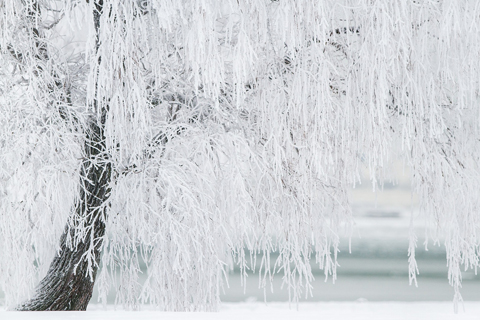
•Freezing temperatures
•Dry soil
•Wind
Solution – Provide your trees with weekly deep waterings through the end of fall and beginning of winter (before the ground freezes) and mulch the area of the root zone for the soil to retain moisture.
For trees that are highly exposed to the wind and sun, wrapping them with burlap will provide an effective barrier which can be removed as temperatures rise.
3 – Improper Pruning, Trimming, and Cutting:
There is a right way, and a right time to perform tree pruning, cutting, or trimming. When performed improperly, the tree may be left exposed to infection and infestation. When done at the wrong time, new growth may not have enough time to adapt before winter, further stressing the tree.
Solution – Know when to prune. Depending on the species of your tree, it may be better to prune in early spring, late fall, or even in the summer months. Use proper pruning or cutting methods when removing limbs, branches, or stems.
Watch this video to learn more about proper pruning techniques.
Tree Insect Infestation
For the most part, healthy trees can stave off insect infestations. However, when a tree’s health is weakened, or there is an increase in the insect population, no tree is off limits.
4 – Insects on Leaves and Bark:
Insects such as aphids, inchworms, bagworms, spider mites, lace bugs, and tree scale are common and relatively easy to manage.
Solution – Apply insecticidal soap, neem oil, or a horticultural oil directly on the area of the infestation.
5 – Boring Insects:
Insects such as the Emerald Ash Borer, Japanese Beetle, Southern Pine Beetle, and Ambrosia Beetle are more complicated to control. You can identify boring insect activity by seeing “sawdust” from their boring activity and the entry hole they create when entering the tree.
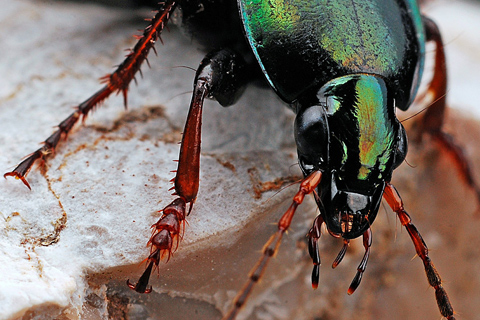
Note: Do not inject insecticides, poisons, or other substances into boring insect entry holes. The chemical may end up further damaging the tree leaving it more susceptible to infestation and death.
Solution 1 – Prune back branches and stems that have been infested and destroy them to prevent further spreading. If more than 25% of the tree’s foliage or mass must be removed, seek the assistance of a certified arborist.
Solution 2 – When the infestation is in the trunk of the tree, call an arborist to evaluate the damage and determine a safe approach to halting the infestation.
Solution 3 – Prevent infestations by keeping your trees healthy. When you hear about an outbreak in your area, treat your trees with a bark insecticidal spray to deter the insects from making your tree its host.
Tree Fungal Diseases
Most fungal diseases make their way into a tree through the roots and open wounds. Once a tree is widely infected, it becomes challenging to control the fungi and will often result in the removal of the tree.
6 – Fungal Infection (internal)
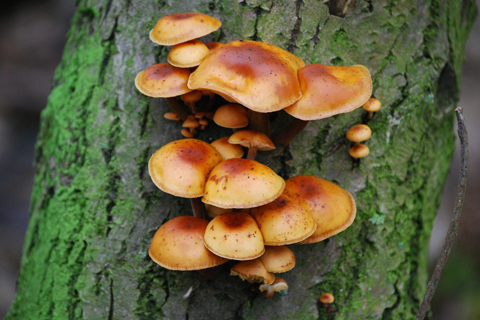
The most alarming sign of fungal trouble is when mushrooms grow on the trunk or branches. Since they require decaying matter to develop, there is a serious issue at play.
Note: The introduction of herbicides to a wounded tree or beneath the bark will only serve to accelerate the death of the tree.
Solution 1 – Prune back and destroy affected foliage, limbs, and branches. Again, when more than 25% of the tree’s foliage or mass must be removed, seek the assistance of a certified arborist. The removal of the tree may be the only way to keep your other trees from being infected.
Solution 2 – Properly prune your healthy trees (or have them pruned) to keep them healthy. A poorly pruned tree is more susceptible to both insect infestation and fungal disease.
7 – Fungal Infection (external)
The wind, birds or insects often carry spores of fungi and pathogens from tree to tree. Cankers, fire blight, rust disease, powdery mildew, and many others are common in the spring and summertime.
Solution – Carefully prune back and destroy affected foliage and apply a fungicidal spray to the affected and surrounding areas. Surrounding trees and shrubs should all undergo treatment as well.
Watch this video to learn about pathogens such as fire blight and cankers which affect tree bark and foliage.
Tree Problems Caused by People and Machinery
All of the threats mentioned above aside, people pose the most significant threat to a tree’s livelihood either by lack of knowledge or accident.
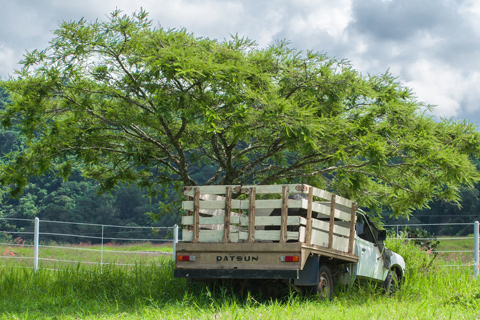
8 – Soil Compaction:
The land that surrounds a tree (especially under its canopy) contains the majority of the roots that draw water for the tree. These roots grow within the top 12 to 18 inches of soil. When this area is compacted, these roots suffocate and die, severely weakening the tree.
Trees compromised by soil compaction are at a heightened risk of toppling in a storm or severe weather event, as their roots are no longer effectively able to anchor them to the ground. Many times, no storm is required, the tree will eventually succumb to its own weight and fall on its own.
Solution – Never drive or park any vehicles underneath a tree’s canopy. Likewise, never store heavy equipment, or erect tool sheds under a tree.
In most municipalities nationwide, tree protection ordinances mandate that protective barriers be placed around trees on construction sites to deter such activities.
The majority of those same ordinances impose heavy fines and replanting requirements known as a recompense for damaged or removed trees.
9 – Lawn Mowers, Motorized Equipment, and Bark Damage:
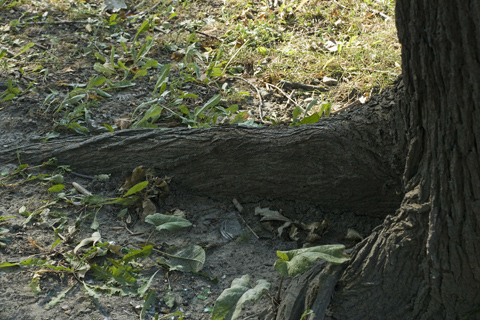
Below the bark of a tree and outer layer of roots, there is a thin layer of cells called the “phloem” which is the conduit for nutrients traveling up and down the tree.
When a tree’s bark is damaged, not only is the tree susceptible to infection and infestation, that flow of nutrients is interrupted and if the damage is around the majority or entirety of the trunk, the tree will be girdled and die.
Solution 1 – Do not allow lawn mowers and other equipment to damage protruding roots or the bark of the tree.
Solution 2 – For protruding roots, either raise the ground level to bury them, or carefully prune them. If you choose to prune the roots, call on a tree professional for detailed instruction or to do the job. Just cutting them out may result in the decline of the tree’s health and its death.
Solution 3 – If the bark of a tree is dried, cracked, or knocked loose, DO NOT remove it. Call an arborist to evaluate the tree’s situation.
Healthy Trees and Arborists
All arborists would agree that healthy, well cared for trees are capable of resisting most infestations and illnesses on their own. However, when a tree does present signs of trouble, knowing what to do can mean the difference between life and death for the tree.
Whether the troubles come from weather, insect, fungi, or people, the solutions are usually simple when detected and treated early. In many cases, to prevent the spreading of a pathogen or the demise of the tree, a certified arborist should be called in to assess the situation and determine a safe course of action.
When your trees show signs of trouble, doing nothing or hesitating to correct the problem may result in the decline of the tree’s health or even its abrupt death.
Sources:
https://www.treesaregood.org/treeowner/planthealthcare
http://www.missouribotanicalgarden.org/gardens-gardening/your-garden/help-for-the-home-gardener/advice-tips-resources/pests-and-problems/environmental/winter-injury/desiccation-or-winter-burn.aspx
https://www.arborday.org/trees/health/issues.cfm
Notice: Undefined variable: page in /home/vrxdg1855sn3/public_html/wp-content/themes/72tree/content.php on line 15
Notice: Trying to get property 'ID' of non-object in /home/vrxdg1855sn3/public_html/wp-content/themes/72tree/content.php on line 15
5 Tree Pests and Diseases to Avoid this Spring
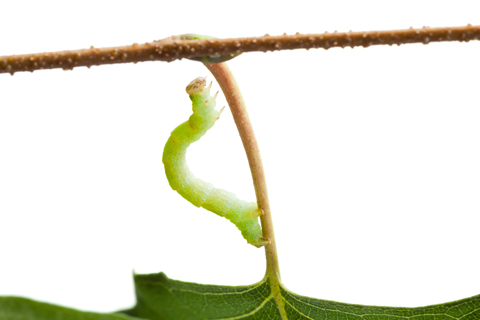
Spring has arrived and with the new season comes new tree problems. It isn’t just the flowers blooming, trees budding, and pollen everywhere; tree pests and diseases are coming alive as well.
Generally, when winter weather and lower temperatures are sustained throughout the season, pests and disease won’t pose much of a threat in the spring. This year however, winter weather and temperatures were relatively mild, favoring the spread of disease and increasing pest population. It’s just the beginning of the season, and there is great potential for tree damage this spring.
The arborist at 72 Tree, Seed & Land Co. identified 5 common tree killers, and methods to get them under control this spring. Also being discussed are routine tree and landscape inspections, pest and disease prevention, and ongoing tree care throughout the year.
3 Common Spring Tree Pests
While there are a wide variety of tree pests, the following have been singled out due to the extent of the damage they can cause. So take heed because, the damage often goes unnoticed until removal of the tree is necessary.
Bagworms – If the leaves on your tree are turning brown or the needles are falling off of your pine, the culprit may be bagworms. Your tree is their food, and as they consume, your tree is unable to produce vital nutrients to keep it healthy and alive.
These worms make a bag-like nest (thus the name) which is often mistaken for a pinecone. In the fall, they mate and each female bagworm is able to lay over 500 eggs that hatch in mid spring.
There are two effective ways of controlling bagworms. You can physically remove and destroy the “bags”, or apply a pesticide in the spring as they are hatching. Once you have confirmed that bagworms have invaded your landscape, you will likely need the help of a professional tree service to keep them under control.
Cankerworms – Also known as inchworms, cankerworms chew away at the foliage of your trees. There are two species of this pest “fall cankerworm” and “spring cankerworm” but don’t let the name mislead you, they both hatch in the spring and feed on the same trees.
The damage they inflict on trees is more stress related and potentially leads to dieback, borer damage, and even root decline. For a healthy tree, one year of cankerworm defoliation won’t necessarily result in the loss of the tree. However, multiple years of defoliation will weaken the tree, making it susceptible to other pests that can ultimately lead it to its death.
When there is a breakout of this pest, there are two principle treatments.
1) Banding the trees in the fall (the wingless females stick to the band and cannot reach the canopy to deposit their eggs) is one very effective measure.
2) The other is the use of pesticides shortly after the worms have hatched. This measure is only effective while the worms are small and should be monitored by an arborist to ensure proper control is achieved.
Southern Pine Beetle – (Dendroctonus frontalis) These boring tree killers are known as the most destructive forest insect in the southern states. The signs or symptoms of an infestation are severe dieback, browning, and eventual death of entire limbs, foliage, and the tree itself.
Once this beetle attacks and succeeds at making a tree its host, the adults emit a pheromone attracting other beetles to the tree. In a matter of days, a tree’s defenses can be overrun by thousands of beetles. As one tree becomes overpopulated, the beetles will seek out nearby trees to colonize, thus expanding their population and local infestation potential.
It is the older and weakened trees that are more susceptible to beetle infestation. Control is accomplished by promoting the health of your trees, and when there is a breakout, applying insecticides to the tree bark is an alternative.
If you have a tree affected or infested by southern pine beetles, you will need an arborist to help identify witch, and if measures can be taken to thwart the infestation.
2 Common Spring Tree Diseases
Throughout the lifecycle of a tree, it may be faced with a number of fungal invaders from its roots to its leaves. While a tree builds a natural resistance to these invaders, trees are not completely immune and can be severely debilitated. The following tree diseases are ones that should be addressed immediately after being diagnosed.
Fire Blight – (Erwinia amylovora) Is a contagious plant disease. Blight is a hard to control pathogen that robs plant and tree foliage of its nutrients, causing the blackening and death of that foliage. Fire blight differs from dieback in that it leaves behind the appearance that the foliage has burned. Thus the name.
Blight is most successful in the springtime, as temperatures and humidity remain ideal for its growth. As with other pathogens, it is spread from host to host by physical contact, insects, birds and other wildlife; be careful when working in the garden because even the tools used for landscape maintenance can transmit fire blight disease.
Moreover, there is no known cure for blight. Control is achieved by pruning and destroying the affected foliage and limbs. The use of pesticides can also aid to control the pest population. As stated, the proper cleaning of equipment after use is helpful to avoid its proliferation. While the planting of resistant or tolerant species is an effective and proactive approach to overcome this disease.
NOTE: When cleaning garden and landscape equipment after handling diseases such as blight, applying a bleach solution (1 part bleach to 4 parts water) to your tools is recommended to neutralize the pathogen.
In the following link we discussed preventing fire blight tree disease in more depth, so check it out for more solutions and detail of this devastating disease.
Heart Rot – Heart rot is a fungal disease causing the softening and decay of the wood found at the center of a tree’s trunk and branches. When you see mushrooms or fungus conks attached to the trunk or branches of a tree, it can be a strong indicator that heart rot is present within the tree.
Fungi enter the tree through damaged bark or poorly pruned ares, move to the heartwood, and begin the process of decay. Softening of the heartwood leaves trees structurally weak and prone to collapse or breakage.
Hardwood trees are affected by heart rot on a global scale, and is extremely difficult to prevent. However, if a tree is growing vigorously, it may be able to isolate the affected portion of itself through a process called compartmentalization.
Control of this destructive disease may be achieved by keeping your tree healthy through proper pruning techniques, annual inspections by an arborist, and post storm maintenance and pruning.
Routine Tree and Landscape Inspections
Tree and landscape inspections start with you. When you’re out mowing, watering, pruning, or playing in your yard, observe the plants, shrubs, and trees. Look for insect infestations, discoloration in the foliage, and dieback of the limbs and crown. For more on dieback and signs of a diseased tree, visit 72tree.com/signs-diseased-tree-dieback-suckers-water-sprouts/
Once a year, hire an arborist to thoroughly inspect your trees and the plant life in your yard. They are trained to spot potential health issues, and implement the best solutions to save and/or extend the lives of your plants.
Prevention and Continued Care
The best preventative maintenance for your trees and plants is the consistent and continued care that you provide them. Healthy plants have the strength to develop defense systems that ward off both pests and disease.
Proper and timely pruning, watering, and fertilizing will help your trees reach maturity faster and in a stronger and more resistant way.
Controlling Pests and Disease All Year
Every pest has its season and every season has its pests. As you have probably gathered by now, the best way to control pests and disease is by keeping your trees, shrubs, and plants healthy through remaining proactive and aware of their state.
Pest control will help in stopping the spread of pathogenic fungi and bacteria, as well as curbing some of the more voracious insects. Fungicides will also help keep many of the pathogens away from your landscape’s ecosystem.
Keep your trees healthy this spring and for years to come by knowing what to look for and which steps to take. And when something strange pops up, call on your local arborist to address and get it solved.
